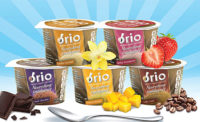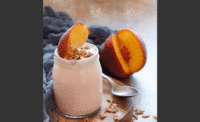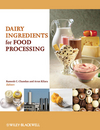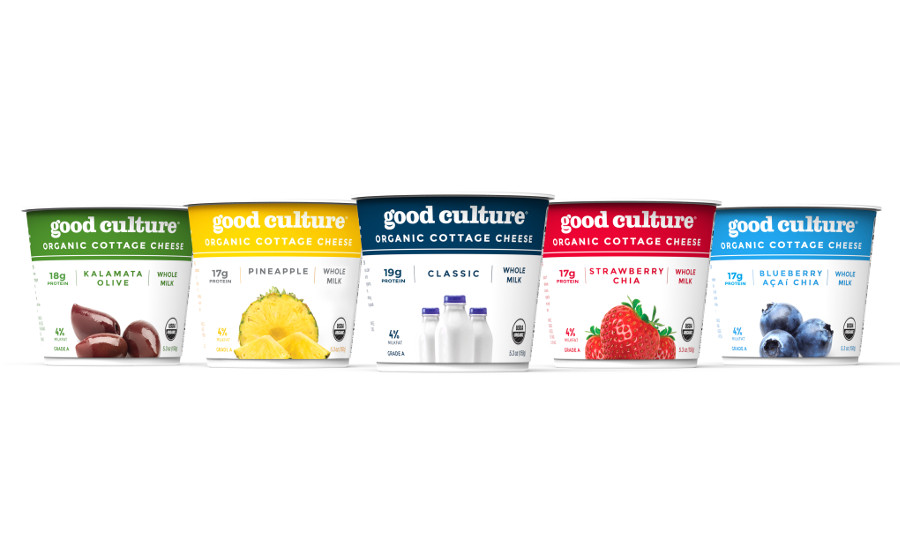Cultured dairy strives to be more 'au naturel'
Category trends include use of whole milk, sugar reduction and cleaner ingredients. Drinkable yogurts, innovative snack pairings and flavor innovations help grow the market










Several trends are growing within the cultured dairy market, specifically with yogurt. Manufacturers are capitalizing on the clean eating movement as cultured products that are functional, whole milk, grass fed and lower in sugar are becoming more popular. Flavor mash-ups (including sweet heat, inclusions or pairings), snacking options and yogurt drinks are also helping to expand the consumer base.
Kyle Wehner, CEO and co-founder of Dreaming Cow, Pavo, Ga., said he sees a rise in functional foods, especially with cultured dairy.
“(Consumers are) looking for foods with a purpose and a vision. It’s why nutrition on-the-go is rising in popularity,” he said.
Wehner also said to keep an eye out for several other growing trends, like probiotic consumption, nutrient density (i.e. vitamins, high-protein), more transparency from food companies and hidden vegetables.
“Everyone is encouraged to eat more vegetables, but only very few consumers get the recommended daily serving,” he said. “However, health and immunity is still important to the consumer, so more consumers look for an easy and delicious way to add more vegetables. Flavor seems to be the biggest obstacle.”
Looking to contribute to this need, this summer Dreaming Cow is launching a line of grass-fed yogurt drinks that contain a full serving of vegetables per 12-ounce bottle. Called Lush, the drinks come in four varieties, including strawberry-raspberry-purple carrot and beet; and lemon-passionfruit-carrot and pumpkin. A bottle contains 11 to 13 grams of protein and includes probiotics.
Atanas Valev, founder of Trimona Bulgarian Yogurt, Port Jefferson, N.Y., said, “In the yogurt world, the biggest development is the cooling off of Greek. Once red-hot, now the segment is flat or declining. This, in turn, has opened the door for other tasty and healthy yogurt types such as Bulgarian, Icelandic, Indian, Russian, etc. We feel diversity and choice helps everyone.”
Trimona added four flavor varieties (including honey ginger cinnamon and raspberry coconut) to its line of non-strained whole-milk Bulgarian yogurt at the end of last year. The company also updated its packaging with what Valev called “trippy, colorful packaging [that] incorporates Bulgarian folklore patterns and more modern design elements.”
A snapshot of the numbers
According to a recent market report published by Albany, N.Y.-based Transparency Market Research, the North America yogurt market was valued at $11.18 billion in 2015 and is expected to reach USD 14.59 billion by 2024, growing at a compound annual growth of 3% from 2016 to 2024. Analysts project that the North America yogurt market will benefit with more product diversification and improved packaging methods that have enhanced the shelf life of the product.
Though the yogurt category is expected to grow, current numbers show overall sales are actually down. Dollar sales dropped 1.4% to $7.5 billion and unit sales dipped 6.2% to 4.9 billion, according to Information Resources Inc. (IRI), Chicago, for the 52 weeks ended Jan. 22, 2017.
A 2016 report from Chicago-based Mintel shows the spoonable yogurt segment still accounts for the majority of sector sales. Valued at $8.2 billion in 2016, spoonable yogurt represents 90% of all yogurt and yogurt drink sales and is expected to continue steady growth moving forward to reach $10 billion by 2021.
In terms of overall sales, the market for yogurt and yogurt drinks is expected to reach $11.4 billion in 2021, said Mintel. Sixty-six percent of US adults purchase spoonable yogurt, while 30% purchase yogurt drinks.
Norwich, N.Y.–based Chobani surpassed Yoplait, a brand of Minneapolis-based General Mills, as the top US yogurt brand in sales and market share, according to Nielsen. Chobani’s market-share of the overall spoonable yogurt category is currently 19.5, Yoplait’s is 18.6.
Sales in other cultured categories show mixed results. The cream cheese category’s sales were up 3.9% to $1.6 billion, but unit sales dropped 0.1% to 663 million, per IRI’s data for the 52 weeks ended Jan. 22, 2017. In the $1.2 billion sour cream category, dollar and unit sales both increased, up 2.3% and 1.2%, respectively. Unit sales were $621.6 million. The cottage cheese category showed dollar sales down 1.8% to $1 billion, though unit sales rose 0.5% to 433.9 million.
Fat is back
The common theme among most of the processors we spoke with was the resurgence of whole-fat milk.
Mintel noted that full-fat options are popular among millennials as they are the most likely (22%) demographic to purchase whole-fat yogurt/yogurt drinks (compared to 16% overall).
Tim Joseph, CEO of Maple Hill Creamery, Stuyvesant, N.Y., attributed some of the whole-milk hype to consumers’ desire for “cleaner labels” and “less processed options.”
“We’re advocates for keeping the milk as natural as can be. That means we keep the milk just as nature intended, full-fat and all,” he said. “Full-fat dairy is definitely having a moment – and rightfully so. Fat contributes to good taste and texture of foods, is essential for the absorption of certain vitamins and also promotes fullness.”
Maple Hill Creamery introduced several new whole-milk products this year, including two flavors to its cream-on-top line (strawberry banana and apple cinnamon); and a maple-flavored kefir. The company also added drinkable yogurts in three flavors — coffee, mango-peach and strawberry. A 12-ounce serving contains 13 grams of protein.
“Fat is definitely back. There’s been a huge trend in whole milk over the last several years in numerous dairy categories, and it’s a source of growth in yogurt, said Lara Gish, category manager for Tillamook County Creamery, Tillamook, Ore. “People have discovered that higher milkfat can be part of a healthy diet in moderation – it’s more satiating and it tastes amazing.”
Jumping on this trend, Tillamook developed a line of single-serve whole-milk Farmstyle Greek yogurts in six flavors, including Mexican vanilla, raspberry fig, clover honey and strawberry black currant.
Siggi Hilmarisson, founder of New York-based siggi’s, maker of Icelandic-style strained yogurts, launched a whole-milk drinkable yogurt line (in three flavors) and triple cream yogurts. The triple cream yogurt, which is made with whole milk and cream, is inspired by a recipe the founder’s mom used when he was a child. She would mix plain skyr with whipped cream and then add fruit. The yogurt is 9% milkfat and comes in raspberry, lemon and vanilla flavors. The company also has a line of 4% milkfat yogurts.
Smari, Petaluma, Calif., was ahead of the curve several years ago when it launched its whole-milk line, and it added two new flavors this year — blackberry and mango — bringing the total to eight flavors in its line.
To address the trend, Yoplait relaunched its whole-milk Custard yogurt line, after a long hiatus. The line has a new cleaner recipe (no high fructose corn syrup, no artificial colors or flavors) and updated packaging.
The whole-milk trend is not limited to yogurts. Los Angeles-based Good Culture cottage cheese relaunched its product last year with a new whole-milk recipe and updated cleaner packaging. The company offers flavored cottage cheeses in fruit and savory flavors, like fruit-on-the-bottom strawberry chia and kalamata olive. Its milk is also sourced from grass-fed cows.
Cleaner and less sugar
According Nielsen’s Spotlight on Added Sugar report, across the United States, 22% of Americans are restricting their sugar intake, while 52% are actively trying to avoid artificial sweeteners. The US Government has echoed these sentiments by introducing changes to nutritional labels in hopes of creating greater transparency. In July 2018, food processors must state the amount of added sugars.
Siggi Hilmarisson said, “The most prevalent trend that we have noticed is that consumers are looking to cut down their sugar intake since more than ever people are consuming over the recommended amount.”
He said that siggi’s products have at least 25% less sugar than most leading flavored yogurts. The company’s nonfat strawberry flavor contains 11 grams of sugar per 6-ounce serving, and its 4% strawberry-rhubarb flavor contains 8 grams of sugar per 4-ounce serving. For comparison, Yoplait’s low-fat strawberry yogurt contains 18 grams of sugar per 6-ounce serving (although that has been lowered from 26 grams previously).
Maple Hill’s Joseph said they keep added sugar to a minimum with its sweet yogurt flavors, preferring to use a small amount of organic cane sugar, maple syrup or real fruit puree to achieve the sweetness level. The company’s strawberry Greek yogurt contains 13 grams of sugar per 5.3-ounce serving, and its strawberry-banana cream-top yogurt contains 15 grams of sugar per 6-ounce serving.
“We haven’t had to reformulate our products or production, because we have always made our products with minimal processing and minimal added ingredients,” he said. “Our products are clean from start to finish in terms of our production. This is one of the reasons why we’re proudly 100% grass-fed.”
Diana Danoff, associate brand manager for Organic Valley, LaFarge, Wis., said “Incorporating savory is a great way to add variety and flavor, which consumers are looking for in cultured dairy products, without adding a lot of sugar.”
She added, “As consumers are eating yogurt more frequently, I think we’ll definitely see a continued rise in savory in yogurt. Millennials are very adventurous and open to trying new flavors, and I think they will be open to these new flavor combinations in dairy categories across the board.”
Tillamook listened to customers’ requests and reduced sugar in one of its yogurt lines, along with updating its packaging.
“The Good & Creamy yogurts are now made with 25% less sugar than the prior recipe, and have 9 grams of protein. We also got away from gelatin and modified corn starch which we felt didn’t hold up to our ‘Dairy Done Right’ philosophy,” said Tillamook’s Lara Gish.
The strawberry flavor now contains 21 grams of sugar per 6-ounce serving. The company also added two new flavors: Hood River pear from Oregon’s Hood River and maple vanilla featuring Vermont maple syrup.
On-the-go dairy
According to Mintel, sales of yogurt drinks grew 62% in the five years 2011-2016, to reach $893 million. Though still a relative newcomer to the yogurt sector, yogurt drinks are a standout in the yogurt market. As Mintel noted, when it comes to eating occasions, 93% of consumers eat yogurt/yogurt drinks at breakfast. But the market appears to be gaining ground in the snacking arena. More than nine in 10 (93%) yogurt/yogurt drink users say that they consume these products as a snack. Mintel research shows that more consumers are choosing yogurt as a snack today than in previous years, as 84% choose yogurt as a morning or afternoon snack (respectively), up from 37% who chose it as a morning snack and 41% who snacked in the afternoon in 2014.
Both Chobani and Dannon added drinkable options to their lines last year. Chobani Drink is available in four varieties, including strawberry banana and mixed berry. It contains 14 grams of protein per 10-ounce serving. Dannon introduced its drinkable yogurt in its nonfat Oikos line, available in strawberry, mixed berry, banana crème and vanilla flavors. A 7-ounce serving contains 10 grams of protein.
Lala, a brand of Dallas-based Borden Dairy, launched two functional yogurt drinks (Healthies Curb and 100 Calorie) last year. Curb combines grains, proteins and fiber to provide a satiating product. It contains 10 grams of protein per 6.7-ounce bottle.
Many processors we spoke with noted that the increase in consumer snacking and desire for more easy protein has definitely fueled the interest and growth in yogurt drinks. And this snacking phenomenon has opened the door for other new product innovations that target the snack-hungry consumer.
To help fill the need for more snack options throughout the day, Yoplait launched Dippers — nonfat Greek yogurt paired with crunchy snacks made for dipping. The yogurt is available in six varieties, including caramelized banana with chocolate-drizzled pretzels; and vanilla bean with honey oat crisps; and a savory flavor — chipotle ranch with tortilla chips.
“Delicious, versatile snacks that fit into consumers’ on-the-go lifestyle are definitely trending right now. Consumers are consistently looking for portable snacks that are protein-packed and fulfilling,” said Gerard Meyer, CEO of Muuna cottage cheese, New York.
Muuna jumped into the cottage cheese market last year with its single-serve flavored cottage cheese line. Sold in 5.3-ounce containers, it’s available in five fruit-on-the-bottom flavors and a plain flavor. The cottage cheese contains 15 grams of protein per 5.3-ounce serving.
Koel Thomae, co-founder of noosa yoghurt, Bellvue, Colo., said to expect “to see innovation in dairy around satisfying different day parts and bringing more single-serve meal type convenience in the category.”
This year, noosa focused on flavor innovation for its whole-milk Aussie-style yogurts, adding three globally inspired flavors — orange-ginger, strawberry-hibiscus and pear-cardamom. The flavors feature fruits, mixed with herbs and spices.
A final note
Nielsen reported, over half of US respondents (56%) strongly or somewhat agree they’re willing to pay more for foods and drinks that don’t contain undesirable ingredients. Manufacturers would be wise to keep an eye on consumers changing their diets and look to implement innovative, healthy ways to sweeten products using natural ingredients, Nielsen noted. Additionally, focusing on products across the board that are simple, convenient and promote less processing will help target consumers who look to make better decisions on the foods they use to fuel their bodies.
Dipping into cultured dairy
The innovations taking place in the cultured dairy market aren’t all about spoonable and drinkable varieties. Unique dips and spreads are showing up in stores that often feature a hybrid of sour cream, yogurt or cream cheese, and in innovative flavor combinations.
Carlinville, Ill.-based Prairie Farms launched a specialty sour creawm-based dip line called Chef’s Splendor that is on-trend with an evolving consumer palate. The dips are available in three flavors: spicy ranch, Tzatziki and roasted red pepper. The company states on the package that the dips are made in small batches and only with natural ingredients. It’s sold in clear containers that feature crisp images of the corresponding flavors, which allow consumers to easily identify the varieties.
Bolthouse Farms, Bakersfield, Calif., created a new line of refrigerated, yogurt-based spreads called MAIO. The line is made with clean ingredients (like milk, water, corn starch, salt and cane sugar). It comes in three varieties: plain, chipotle and garlic.
Chobani made news with its jump beyond the yogurt aisle last year with its Mezé Dips, a savory Greek yogurt dip line. Flavor varieties included smoked onion Parmesan and three-pepper salsa. A 1-tablespoon serving contains 3 grams of protein.
Yogurt in great position to grow in foodservice
In a press release from Dannon Foodservice and according to Technomic’s 2016 Snacking Occasion Consumer Trend Report, 60% of consumers are seeking healthier snacks. Per Mintel data, parfaits are up 10% and smoothies are now number five of the top 10 drinks on restaurant menus. Research also shows that consumers will pay 34% more for items made with Greek yogurt, according to Technomic MenuMonitor.
According to Dannon’s press release, Greek yogurt is perfect for parfaits and smoothies because the thicker texture allows for longer hold times. The balanced flavor profile of the company’s Oikos Greek nonfat yogurt gives options for chefs and operators to explore both sweet and savory parfait and smoothie applications, said the company. In addition, its ideal consistency creates creamier smoothies with no separation and parfaits with crunchier granola and less color bleed from fruit.
Mike Miles, vice president of sales of Dannon Foodservice said, “As consumer demand for healthier snacks increases, we know yogurt can serve as a flexible ingredient for menu items that can be served throughout the day.”
Dannon Foodservice offers an assortment of bulk yogurt products, including traditional, Greek, nonfat and low-fat options in plain, vanilla and strawberry flavors. Depending on the preference, its yogurt is available in 32-ounce plastic tubs or 6-pound resealable bags. The company offers several on-trend recipes for menus using its yogurt (including parfaits and smoothies), which can be found on its website.
Looking for a reprint of this article?
From high-res PDFs to custom plaques, order your copy today!













